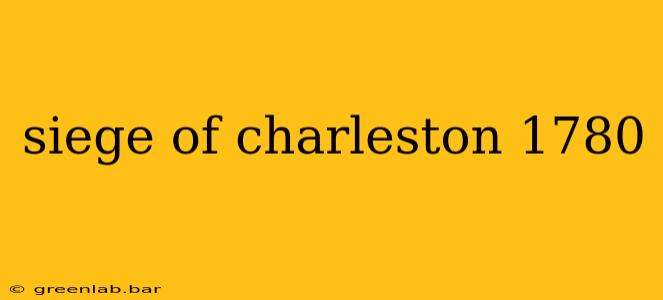The Siege of Charleston, lasting from March to May 1780, stands as a watershed moment in the American Revolutionary War. This pivotal battle resulted in a devastating British victory, significantly altering the strategic landscape of the conflict and marking a turning point in the Southern theater. Understanding the siege's intricacies requires examining its causes, the military strategies employed, and the profound consequences it had on the course of the war.
The Prelude to Siege: A Vulnerable City
Charleston, South Carolina, held immense strategic importance. Its harbor was crucial for trade and communication, and its capture would provide the British with a vital foothold in the Southern colonies, a region seen as more loyalist-leaning than the North. British General Henry Clinton, after securing New York, recognized this vulnerability. He planned an ambitious campaign focused on exploiting this weakness and severing the rebellious colonies' supply lines. The city's defenses, while formidable in parts, were ultimately insufficient against a determined and well-supplied British army. The American forces, under the command of General Benjamin Lincoln, were outnumbered and faced internal challenges, including a lack of vital supplies and disagreements regarding military strategy.
The Siege: A Month of Brutal Combat
The siege itself unfolded over several weeks, characterized by a relentless bombardment and fierce fighting. Clinton’s forces, significantly outnumbering Lincoln's troops, methodically tightened their grip on the city. The British employed superior artillery and naval power to pound Charleston’s defenses, systematically weakening the city's fortifications. The American forces, facing overwhelming odds and dwindling supplies, mounted determined but ultimately unsuccessful defenses. The siege witnessed intense artillery duels, desperate sorties, and fierce close-quarters combat. The relentless bombardment caused significant damage to the city and took a heavy toll on the civilian population.
Key Factors in the British Victory:
- Superior Naval Support: The Royal Navy's control of the Charleston harbor proved instrumental, effectively cutting off American supply lines and allowing for a concentrated assault on the land defenses.
- Numerical Superiority: The British forces significantly outnumbered the American defenders, allowing for a multi-pronged attack and the effective encirclement of the city.
- Effective Siege Tactics: Clinton’s strategic approach, combining naval power with a methodical land assault, effectively overwhelmed the American defenses.
- American Strategic Mistakes: Lincoln's strategic decisions were arguably hampered by internal conflicts and insufficient resources.
The Fall of Charleston and Its Aftermath
On May 12, 1780, after a grueling siege, General Lincoln surrendered Charleston to the British. This defeat marked a significant blow to the American cause, resulting in the capture of thousands of American soldiers and a vast quantity of vital war materials. The fall of Charleston also emboldened Loyalist support in the South, giving the British a crucial base of operations to launch further campaigns into the region. The loss was a devastating blow to American morale, while the British victory propelled their Southern strategy forward.
Long-Term Consequences and Legacy
The Siege of Charleston had far-reaching consequences, impacting the overall strategy of the war. The British victory opened the door to extensive campaigns throughout the South, leading to brutal battles and prolonged warfare. However, it also spurred increased colonial resistance in the region and ultimately contributed to the eventual American victory. The siege's legacy continues to inform our understanding of the American Revolution's complexities, highlighting the strategic importance of the Southern theater and the challenges faced by both sides during this pivotal moment in history. The resilience and subsequent resistance displayed by the colonists in the face of such a substantial defeat underscored the determination and unwavering commitment necessary for achieving independence. The Siege of Charleston, a dark chapter in the American Revolutionary War, nevertheless served as a powerful catalyst, shaping the course of the war and solidifying the resolve of the colonists in their fight for freedom.

